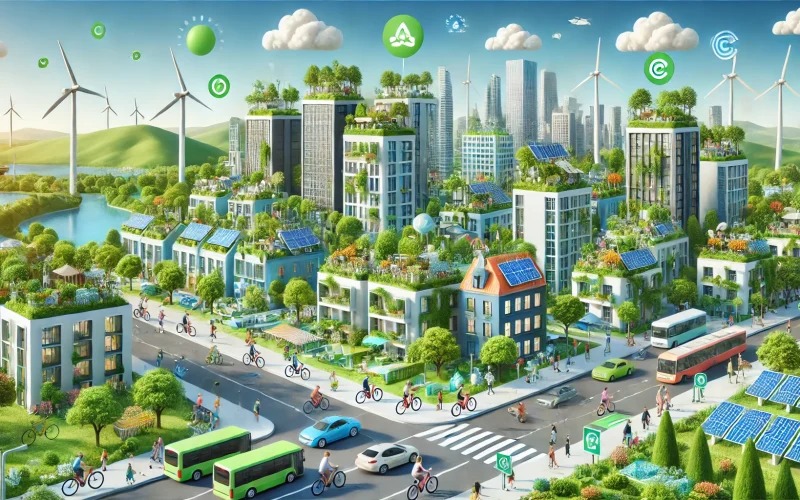Key goals at the EU level under the Revised Directive on Energy Performance of Buildings
On 12 April 2024, the Council of the European Union adopted the revised text of Directive 2010/31/EU on the energy performance of buildings (the “Revised Directive”). The Revised Directive was published in the Official Journal of the European Union on 8 May 2024 and Member States will have to transpose it into national legislation within 2 years of its entry into force (i.e. 28 May 2024).
The Revised Directive on the energy performance of buildings marks a significant step towards achieving climate neutrality and reducing the environmental impact of the real estate sector across Europe.
This directive sets forth ambitious objectives and guidelines aimed at revolutionizing the energy efficiency standards in buildings, with a focus on mitigating energy consumption and greenhouse gas emissions. The Revised Directive outlines a comprehensive strategy that entails a gradual transition to zero-emission buildings, the renovation of inefficient constructions, and the gradual phasing out of fossil fuel power plants. The key objectives include:

According to the European Commission, buildings in the European Union are responsible for 40% of final energy consumption in the European Union and 36% of its energy-related greenhouse gas emissions, while 75% of the European Union’s buildings are still energy inefficient and 85-95% of the buildings that exist today will continue to exist in 2050.
However, considering that the current weighted yearly rate of energy renovations in the EU is about 1%, at this rate it would mean that it would take centuries to decarbonize the building sector. It is estimated that, following the introduction of these requirements, around 30% of buildings in the EU will need to be renovated by 2030 and 80% by 2050.
Given the current state of the building stock in the European Union, the directive emphasizes the importance of sustainable building materials, effective thermal protection measures, and the widespread adoption of renewable energy installations. These measures are essential in ensuring the longevity and environmental sustainability of buildings, particularly in the face of climate change challenges and rising energy demands.
Amongst other measures, Member States are responsible for ensuring that new buildings are designed for the installation of photovoltaic panels and exact deadlines are also provided for the installation of photovoltaic generation capacities on existing buildings.
The Revised Directive also provides for the introduction of renovation passports for buildings, which are designed to help building owners plan a phased renovation of their buildings, with the ultimate aim of significantly improving energy performance. Passports will take into account specific building characteristics such as type and year of construction, existing insulation, heating and cooling systems and will present a series of renovation recommendations that the owner can implement gradually, depending on budget and priorities.
Impact of the Revised Directive in Romania
Romania has a significant stock of old and energy inefficient buildings, since about 80% of Romania’s buildings were built before 1990, when energy efficiency standards were much lower. This leads to high energy use and greenhouse gas emissions.

According to the European Commission, Romania’s non-residential buildings are renovated at an average rate of 1.9% per year, and only 0.4% of them undergo major renovation. (Credit: Via Lite Communications)
The Revised Directive targets to boost the renovation of existing buildings in Romania and the construction of new buildings to higher energy standards. It is estimated that around 2 million buildings in Romania should be renovated by 2030, but this will require significant annual investment of around 20 billion EUR by 2030.
The Directive 2010/31/EU on the energy performance of buildings was initially transposed into national legislation under Law 372/2005 on the energy performance of buildings. A draft law amending Law 372/2005 is currently under debate in the Parliament in order to adapt the current legislation to the new requirements of the Revised Directive. However, the draft law was submitted for discussion before the final version of the Revised Directive was approved, so we expect amendments to the initiators’ proposal or subsequent amendments to Law 372/2005.
Potential consequences and sanctions
Under the Revised Directive, each Member States must establish the necessary sanctions applicable to infringements of the national legal provisions (to be) adopted pursuant to the implementation of the Revised Directive.
The Revised Directive only requires that the sanctions to be determined by each Member State are effective, proportionate and dissuasive. In this context, to ensure progress towards energy efficiency targets, the Revised Directive introduces stricter monitoring and reporting requirements. Member States failing to comply with the directive could face sanctions, although the emphasis is primarily on providing support and incentives for compliance rather than punitive measures.

In addition to the legal consequences, failure to comply with the provisions of the Revised Directive could lead to higher energy costs, reduced comfort levels for users, and negative environmental impacts.
In conclusion, the Revised Directive is a key instrument to improve the energy performance of buildings and to achieve the EU’s climate and energy goals. By complying with its provisions, EU citizens can benefit from lower energy bills, better living and working conditions and a greener environment.
According to thediplomat.ro
